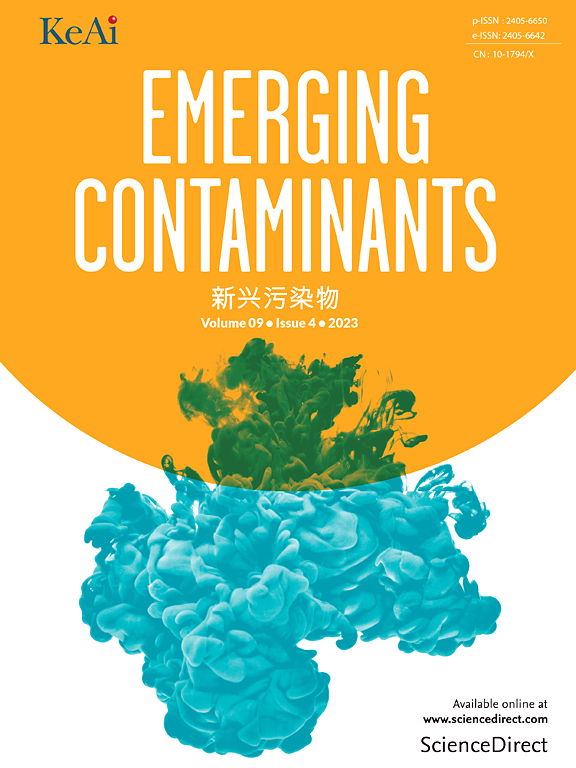鸡蛋中溴化阻燃剂、多溴化二苯并对二恶英和二苯并呋喃及其污染源的研究进展
IF 6.9
2区 环境科学与生态学
Q1 ENVIRONMENTAL SCIENCES
引用次数: 0
摘要
对散养鸡鸡蛋中溴化阻燃剂(BFRs)和多溴化二苯并对二恶英和二苯并呋喃(PBDD/Fs)浓度的数据进行了审查和汇编,并对主要来源进行了分配。在焚烧电子垃圾的地点、垃圾焚烧厂附近、冶金设施和垃圾填埋场/垃圾场检测到散养鸡的池蛋中多溴联苯醚(PBDEs)和PBDD/Fs含量最高。PBDD/F模式表明多溴二苯醚和四溴双酚A (TBBPA)是鸡蛋中PBDD/F污染的主要来源。像DR CALUX这样的二恶英生物测定法可用于筛选总二恶英毒性(PCDD/Fs、dl-PCB、PBDD/Fs和混合多溴-多氯联苯-对二恶英/呋喃(PXDD/Fs))。在仪器分析无法量化二恶英毒性的PXDD/Fs复合体群中,稳健且廉价的生物测定方法是目前唯一可以量化二恶英样毒性的方法。人类接触BFRs的一个主要来源是鸡的鸡蛋,这些鸡蛋从经过BFRs处理的电子废塑料或其他废物/产品中啄出颗粒。当鸡摄入含有污染物的塑料颗粒时,污染物会转移到它们的鸡蛋中。这与海鸟的情况相似。被列为持久性有机污染物(POP)的BFRs中,检测到的最高水平是多溴二苯醚和六溴环十二烷(HBCDD)。HBCDD主要存在于膨化聚苯乙烯(EPS/XPS)中,极易被鸡啄食。这可能是一些受HBCDD污染的鸡蛋脂肪含量超过1000纳克/克和高达18321纳克/克脂肪的原因。EPS/XPS绝热材料含有以前生产的所有HBCDD的90%(约4200万吨EPS/XPS中约64万吨),也部分用作鸡舍和农场和私人住宅的其他部分的绝热材料。因为鸡喜欢啄和吃软聚合物,这可能是一个相关的暴露源。在鸡蛋中检测到多种新型bfr (nBFR)。检测频率最高的nBFR为1,2-二(2,4,6-三溴苯氧基)乙烷(BTBPE)。在国际污染物消除网络(IPEN)的监测中,经常在鸡蛋中发现BTBPE,其含量经常超过10纳克/公斤脂肪,三个样本超过100纳克/克脂肪,最高达221纳克/克脂肪。在使用塑料废物作为锅炉/焚化炉燃料的场所,也经常在鸡蛋中检测到DBDPE,最高浓度为2077纳克/克脂肪。此外,在脂肪含量高于0.1 ng/g的鸡蛋中也经常检测到六溴苯(HBBz),最高水平为30.3 ng/g脂肪。提出了控制鸡肉和鸡蛋接触BFR和PBDD/F的建议,包括将PBDD/F和PXDD/F列入《斯德哥尔摩公约》,更好地控制含有BFR的塑料,包括禁止向发展中国家出口电子废物和塑料废物,更好地控制和无害环境地管理废物焚烧或冶金过程产生的灰烬,改善对含有BFR的塑料废物的无害环境管理,防止回收含有持久性有机污染物的废物,以及替代溴化阻燃剂。本文章由计算机程序翻译,如有差异,请以英文原文为准。
Review of brominated flame retardants and polybrominated dibenzo-p-dioxins and dibenzofurans in eggs and contamination sources
The data on the concentrations of brominated flame retardants (BFRs) and polybrominated dibenzo-p-dioxins and dibenzofurans (PBDD/Fs) in eggs from free-range chickens were reviewed and compiled including assignment to major sources. The highest levels of polybrominated diphenyl ethers (PBDEs) and PBDD/Fs in pooled eggs from free-range chickens were detected at sites where e-waste was burned, near waste incineration, metallurgical facilities and at landfills/dumps. The PBDD/F pattern indicated that PBDEs and Tetrabromobisphenol A (TBBPA) are the major sources for PBDD/F contamination in the eggs. Dioxin bio-assays like the DR CALUX are useful to screen for total dioxin toxicity (PCDD/Fs, dl-PCB, PBDD/Fs and mixed polybrominated-polychlorinated dibenzo-p-dioxins/furans (PXDD/Fs)). The robust and cheap bioassay approach is currently the only method which also quantifies the dioxin-like toxicity of the complex group of PXDD/Fs where instrumental analysis cannot quantify the dioxin toxicity.
A major source of human exposure to BFRs is eggs from chickens that have pecked particles from e-waste plastics or other waste/products treated with BFRs. When chickens ingest plastic particles containing contaminants, the latter are transferred to their eggs. This is similar to what has been documented for sea birds. The BFRs listed as persistent organic pollutants (POP) with the highest level detected were PBDEs and hexabromocyclododecane (HBCDD). HBCDD is mainly contained in expanded and extruded polystyrene (EPS/XPS) which can be easily pecked by chickens. This was likely the reason for several HBCDD contaminated eggs above 1000 ng/g fat and up to 18,321 ng/g fat. EPS/XPS insulation which contain 90 % of all HBCDD formerly produced (∼640,000 tonnes in ∼42 million tonnes of EPS/XPS) is partly also used as insulation in henhouses and other parts of farms and private houses. Since chickens like to peck at and eat the soft polymer, this can be a relevant exposure source. A wide range of novel BFRs (nBFR) were detected in chicken eggs. The nBFR with the highest levels and frequency detected was 1,2-Bis(2,4,6-tribromophenoxy)ethane (BTBPE). BTBPE was often found in eggs in the monitoring of the International Pollutants Elimination Network (IPEN) with levels frequently above 10 ng/kg fat and three samples above 100 ng/g fat, up to 221 ng/g fat. DBDPE was also frequently detected in eggs with a maximum concentration of 2077 ng/g fat at the sites where plastic waste is used as fuel in boilers/incinerators. Also, hexabromobenzene (HBBz) was frequently detected in eggs above 0.1 ng/g fat with highest level of 30.3 ng HBBz/g fat.
Recommendations for controlling BFR and PBDD/F exposure of chicken and eggs are provided including the listing of PBDD/F and PXDD/F in the Stockholm Convention, the better control of plastic containing BFRs including the prohibition of exports of e-waste and plastic wastes to developing countries, better control and environmentally sound management of ashes from waste incineration or metallurgical processes, the improvement of environmentally sound management of BFR containing plastic wastes, prevention of recycling POPs containing wastes, and the substitution of BFRs.
求助全文
通过发布文献求助,成功后即可免费获取论文全文。
去求助
来源期刊

Emerging Contaminants
Medicine-Public Health, Environmental and Occupational Health
CiteScore
10.00
自引率
6.70%
发文量
35
审稿时长
44 days
期刊介绍:
Emerging Contaminants is an outlet for world-leading research addressing problems associated with environmental contamination caused by emerging contaminants and their solutions. Emerging contaminants are defined as chemicals that are not currently (or have been only recently) regulated and about which there exist concerns regarding their impact on human or ecological health. Examples of emerging contaminants include disinfection by-products, pharmaceutical and personal care products, persistent organic chemicals, and mercury etc. as well as their degradation products. We encourage papers addressing science that facilitates greater understanding of the nature, extent, and impacts of the presence of emerging contaminants in the environment; technology that exploits original principles to reduce and control their environmental presence; as well as the development, implementation and efficacy of national and international policies to protect human health and the environment from emerging contaminants.
 求助内容:
求助内容: 应助结果提醒方式:
应助结果提醒方式:


